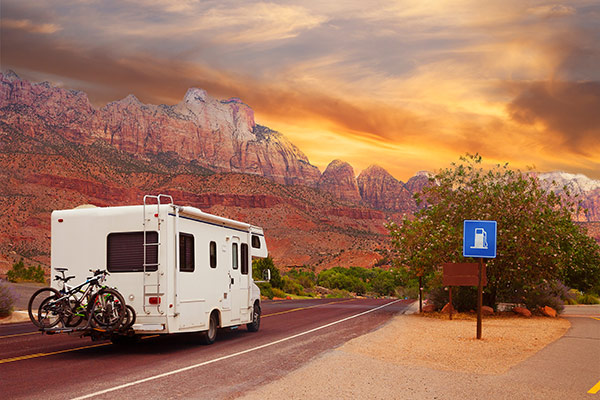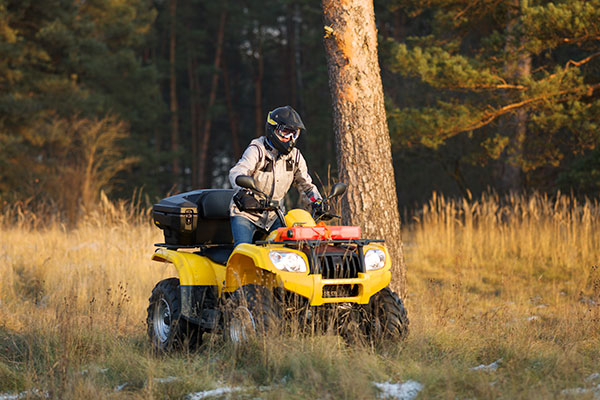Once spring arrives, many recreational vehicle (RV) owners begin to prepare their RV or travel trailer for a new season on the road. However, it’s important to perform some basic RV maintenance in order to make sure your next trip is safe and enjoyable for the entire family. RV maintenance is especially important if your RV has been parked all winter. You probably can’t wait to hit the open road, but imagine how much more fun your spring or summer trips will be when you have peace of mind knowing you’re covered with RV insurance and have completed these spring RV maintenance tasks first.
RV Maintenance Tips – Under the Hood
1. Check The Fluids
Your RV will only go as far as its engine takes it. Check your RV’s fluid levels as part of basic maintenance—this includes power steering, transmission, engine oil, brake fluid, engine coolant and windshield washer fluid. Refill any liquids that are low before you go on your trip. Take your RV to a mechanic if you’re worried about any leaks. You will also want to start the engine to review the readings on the gauges and make sure the dashboard lights, headlights, taillights and windshield wipers are working. Again, if anything is not working properly, see a mechanic.
2. Check The Batteries
If you recharged your RV battery throughout the winter, it should be ready for your first trip of the spring. If you did not, your first step as part of basic RV maintenance is to recharge it—your RV battery could lose up to 10 percent of its current a month while it’s in storage. Only add water to lead acid batteries after they’re fully charged, unless the water level is already below the plates. Make sure the plates are always covered. Once the battery is 100 percent charged, check it and add distilled water as needed. If you’re not comfortable doing this work, contact a qualified service facility.
3. Check The Water System
As part of regular maintenance, your RV’s water system will need to be de-winterized, inspected for leaks and sanitized after being parked during the winter. If you used non-toxic RV antifreeze to winterize your vehicle, run fresh water through the system until all of the antifreeze is gone. Be sure to also replace any water filter cartridges you removed for storage.
RV Maintenance Tips – Exterior of Your RV or Travel Trailer
 4. Check The Tires
4. Check The Tires
Your RV tires can lose air pressure while they are in storage—approximately two to three pounds per square inch (PSI) for every month it sits in storage. So by the time you’re ready for your first spring trip, those tires could be unsafe to drive on. Check the pressure in all of your RV tires—including the spare. Your tire inspection should also include looking for wear and tear, worn down treads and cracks in the sidewalls.
5. Look Out For Leaks
Inspect your RV’s seams and sealants for leaks if you stored it outside during the winter. This includes all roof and body seams as well as any openings that are cut into the vehicle. Reseal all of the cracked seams and sealants before you hit the road. Check with your RV owner’s manual or dealer to make sure you’re using sealants that are compatible with your vehicle’s materials. Please be careful when working on your RV’s roof.
6. Check Your Towing Setup
If you’re hauling a car on your trip, it’s critical that your towing rig is working. Look over all of the connections and welds and be mindful of any cracks. The safety chains should be crossed under the coupling and hooked. Always have a spare set of car keys handy in case you lose the originals. You should also inspect the hitch pieces for rust or damage and replace anything that’s broken. The last thing you want is to be stranded because of a broken hitch—or worse, cause an accident.
RV Maintenance Tips – Inside Your RV or Travel Trailer
 7. Check The Windows And Air Vents
7. Check The Windows And Air Vents
You and your family will want to remain cool in your RV as temperatures rise. Open your RV’s windows and air vents to make sure they are working. Proper airflow will suppress any extra humidity and help keep you comfortable on your ventures. Working air vents become more critical when temperatures drop and you need to turn on the heat—they will prevent toxic gas from building up inside your vehicle. Meanwhile, opening the windows will help “air out” your RV after it’s been sitting in storage all winter.
8. Check Your Safety Devices
Now that you know all of your RV’s mechanical parts are in working order, take a look at the safety devices. You should not go anywhere before you know that your smoke alarm, fire extinguisher, carbon monoxide detector and LP detector are working properly. Buy a new fire extinguisher if the expiration date has passed. Make sure all of your passengers know how to use the fire extinguisher and what every safety alarm sounds like. For even more peace of mind, make sure you’re aware of RV insurance coverage options to protect your investment all year long.
However you hit the road this season, GEICO can help you get covered for the unexpected. From auto, RV, motorcycle, boat insurance and more, GEICO has affordable coverage for the things that move you. Get a fast, free, online quote here.
By Joe Dyton










Leave a comment